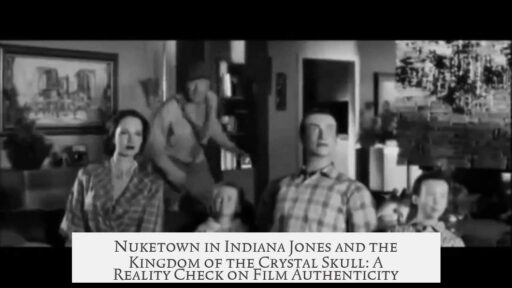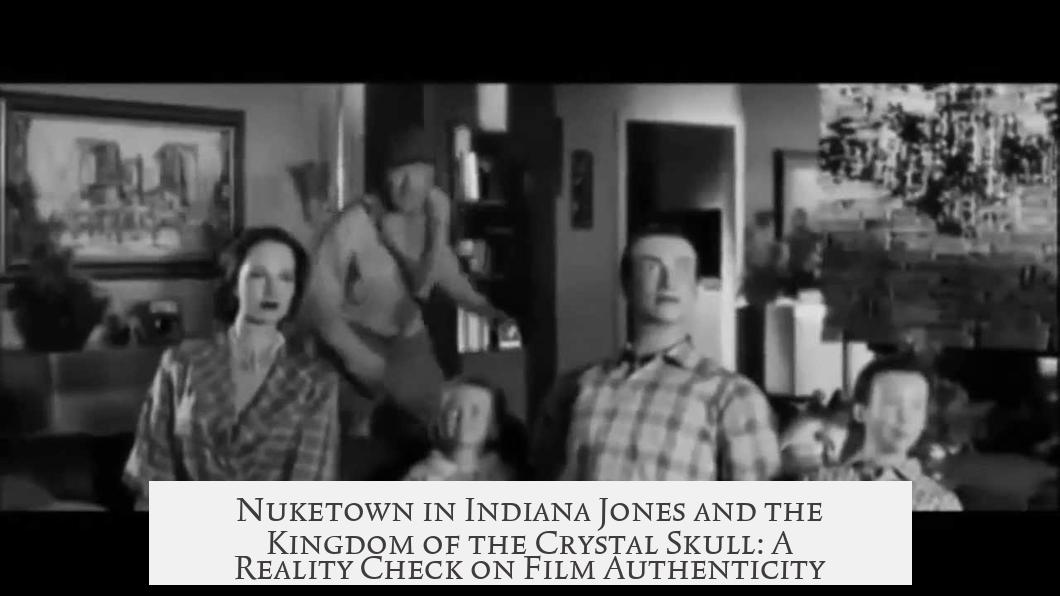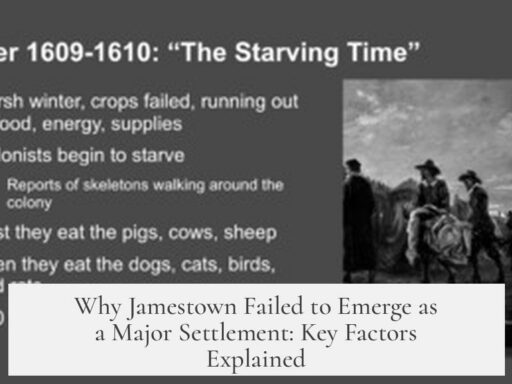The Nuketown depicted in Indiana Jones and the Kingdom of the Crystal Skull is based on a real nuclear test site mock-up known as Survival Town at Nevada’s Test Site Area 1, but the film exaggerates its scale and some details, making it only partially realistic.
The movie draws inspiration from a genuine setup used in the 1950s to study nuclear blast effects on civilian structures during Operation Teapot. Survival Town was built for this purpose in May 1955. It consisted of a small cluster of civilian-style buildings, including two two-story houses and three single-story houses, as well as trailers and cars.
The houses were made from different materials, such as wood, metal, and concrete. This variety aimed to test how diverse construction types withstand a blast. Some homes had built-in shelters that followed the Civil Defense guidelines of the period. Interiors were furnished with period-appropriate appliances and furniture. Mannequins dressed in contemporary clothing acted as simulated inhabitants performing daily tasks.
This attention to detail extended to practical testing. The mock town contained radios, telegraph tapes, photos, microfilm, and other media to gauge how a nuclear attack might disrupt information systems. Food supplies like canned goods were stored in pantries and refrigerators, even covered with soil, to investigate radiation effects on preservation.
Despite these authentic touches, Survival Town was never a real functioning community. It had no electricity or running water, as durable infrastructure was not the focus. Overhead electrical cables were expected to be destroyed during blasts, and practical water sources were deemed unnecessary in the desert test site. The site did include elements like water towers, gas tanks, and electric substations, reflecting some local infrastructure.
Comparing the actual site to the movie reveals clear discrepancies. The film portrays the test town as larger and more developed than the limited few buildings that composed Survival Town. At around seven minutes into the film, the set shown appears extensive, far exceeding the compact size of the real mock-up. The location also is near the iconic Area 51, which fits the timeframe since it was operating nearby by then.
However, the film timeline starts in 1957, two years after the real tests were conducted. The Apple-2 test, closest to what the movie shows, occurred in May 1955. Additionally, while the movie depicts advanced technology like a hypersonic sled, such equipment was not present near Nevada’s test site but rather located in California bases.
Survival Town’s purpose was narrowly scientific. It aimed to measure the effects of nuclear blasts on buildings, equipment, and basic supplies, not to simulate a living community. This explains the staged mannequins, the controlled furnishings, and the lack of true utilities.
| Aspect | Real Survival Town | Movie Depiction |
|---|---|---|
| Scale | Small cluster, 5 houses + trailers | Larger “town” with extended buildings |
| Functionality | No utilities, no real inhabitants | Appears as functioning suburb |
| Construction Materials | Various (wood, metal, brick) | Mix suggested, but less emphasized |
| Mannequins and Interiors | Mannequins in everyday poses with furnished interiors | Not specifically shown in detail |
| Location and Time | Nevada Test Site Area 1, 1955 | Near Area 51, set in 1957 |
| Advanced Tech | None at Nevada site | Hypersonic sled included |
In summary, the Nuketown sequence in Indiana Jones incorporates realistic elements from the Survival Town test site, such as house design variety, mannequins, and testing of survival essentials. Yet, the filmmakers expand the scale and timeline for narrative effect. The original site was a scientific tool with carefully staged but limited realism.
- The real “Nuketown” was a small, staged test site at Nevada’s Test Site Area 1.
- Houses were built from diverse materials and furnished with typical interiors and mannequins.
- The movie inflates the town’s size and starts the story two years after the actual tests.
- The location near Area 51 is accurate, but advanced equipment shown was not present.
- The real site aimed only to study blast impacts, not simulate an inhabited town.
How Realistic Is The Nuketown in Indiana Jones And The Kingdom of The Kingdom of The Crystal Skull?
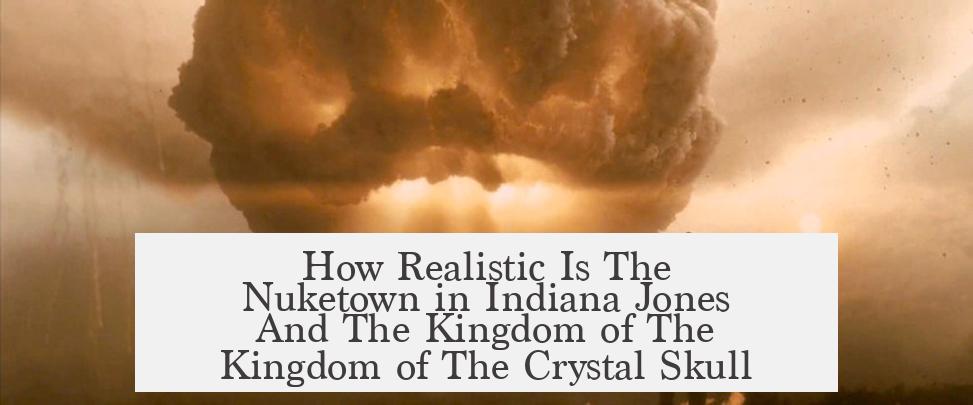
Simply put: The Nuketown set in Indiana Jones and the Kingdom of the Crystal Skull is partly realistic—but Hollywood took some liberties. The inspiration behind the set is genuine, but the movie glamorizes its scale and timing. Let’s dig into why this is both true and not-so-true at the same time.
If you loved the opening scenes with that eerie-looking deserted town, there’s some neat real-world history hiding beneath the dust.
The Real-World “Nuketown”: Survival Town
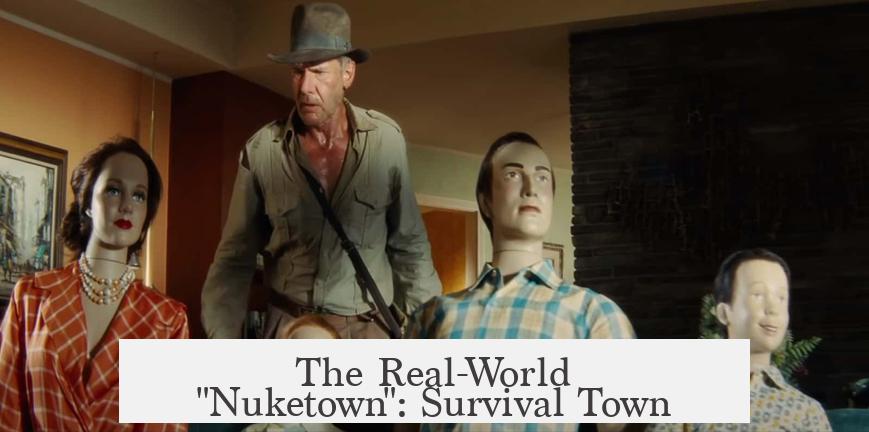
Imagine a mock town, perfectly crafted not for residents, but for nuclear testing. That’s Survival Town, nicknamed so back in 1955, located at Nevada Nuclear Testing Site Area 1. This town wasn’t for weekend getaways. It was a scientific experiment, set up by the Federal Civil Defense Administration to understand how nuclear blasts would affect suburban neighborhoods.
In fact, the movie’s Nuketown is directly inspired by this test site. The town featured a handful of houses—two with two stories, some with one story—and, yes, trailers and cars too. The clever part? Each building was made from different materials.
Wooden frames, brick, concrete, metal sidings—they wanted to see which materials would better withstand shockwaves. Plus, some even had built-in shelters, following the budding Civil Defense guidelines of that era.
Inside the houses, they placed regular furniture and mannequins posed as if going about everyday life. Clothes and fabrics on these dummies helped test how radiation and blast waves would affect real people’s belongings. Imagine mannequins braving atomic tests—harder than a walk in the park!
Movie vs. Reality: Scale and Appearance
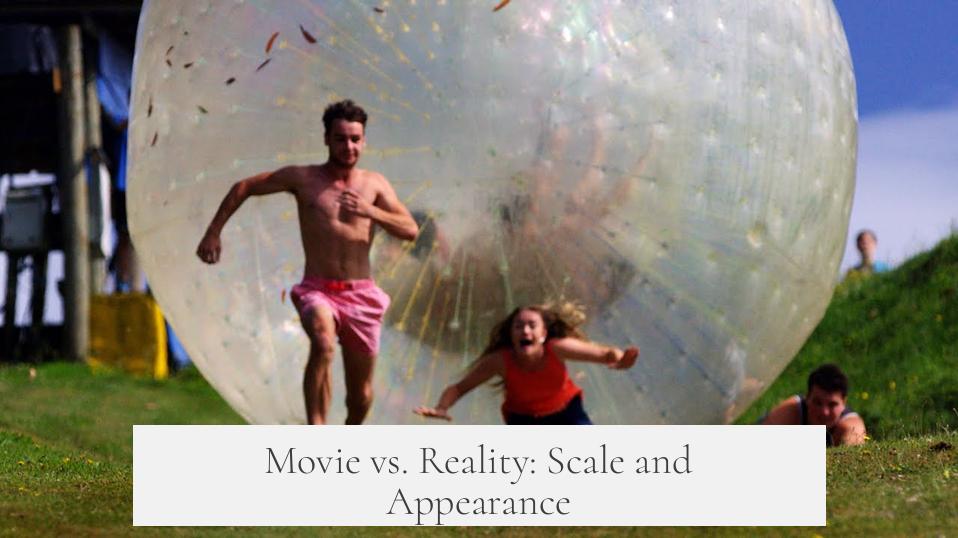
The movie shows Indiana Jones approaching what looks like a full-fledged town. But the real Survival Town was nothing like that dramatic. It was more like a tiny cluster of buildings designed to mimic a small suburb rather than a functioning community.
At just a glance around 7:11 in the movie, the actual mock town’s size is much smaller than the grand scale suggested by the camera.
Did you catch that? The set is larger than life, but the real one was more like a half-abandoned village—or a movie set (which it was, but for nuclear science). So while you get that “post-apocalyptic town” vibe on screen, in reality, it was a highly controlled, compact test site.
Inside the Blast Zone: Realistic Details in Props and Setup
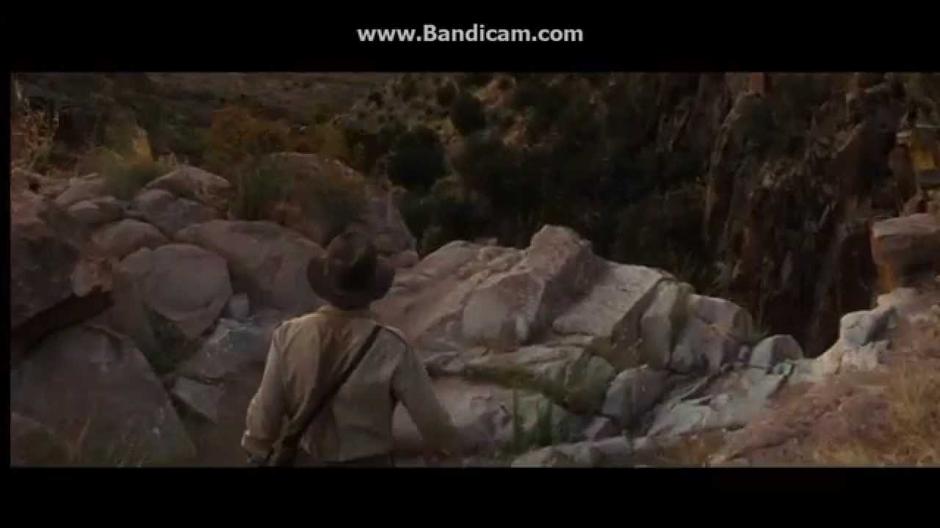
A key point that filmmakers nailed was the interior details. The mock buildings featured typical household items and staged mannequins doing regular chores. These were not props but part of the scientific experiment to test survivability.
- They placed radios, telegraph tapes, paper, photos, and even microfilms to see how information would perish or survive the blast.
- Canned food storage tested radiation impact on supplies kept in pantries and refrigerators, sometimes even buried under soil.
One fun fact: the houses weren’t hooked up to running water or electricity. Since overhead cables were expected to get blasted to pieces, providing power was pointless and an unnecessary expense in the desert environment.
Instead, some infrastructure was there to test its endurance—like water towers, electric substations, and fuel tanks. But typical urban elements like roads and bridges were tested elsewhere at different sites.
Got Your Time Machine? Because the Movie is Slightly Anachronistic
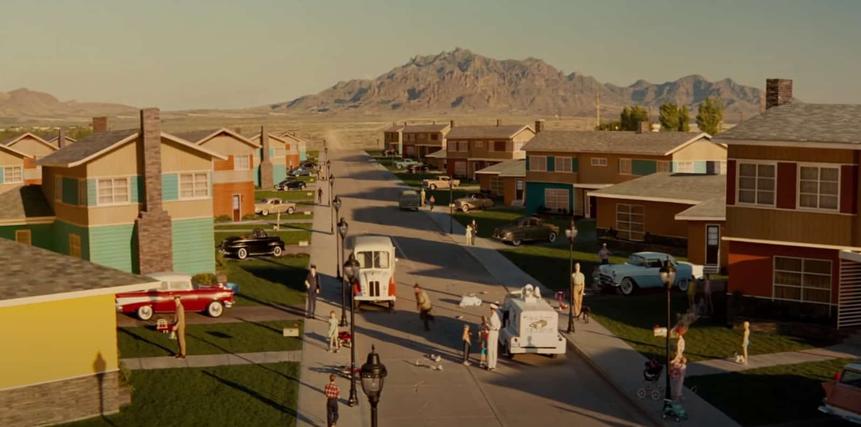
Here’s where the timeline bends a bit. The film starts its Nuketown scenes in 1957. The real tests? They happened mainly in spring 1955. Specifically, the Apple-2 test conducted on May 5, 1955, following a failed Apple-1 test a month later. So the movie takes an extra two years of artistic license.
Geographically though, the movie’s guess is smart. The test site’s proximity—about 20 miles from the famous Groom Lake Air Base (a.k.a. Area 51)—fits well with the narrative, especially since the CIA had been running Area 51 since 1953.
However, one glaring slip is the hypersonic sled track shown in the movie. In reality, none existed near Area 51. The closest were over 200 miles away in California at Naval Air Weapons Station in China Lake and Edwards Air Force Base.
Why Does This Matter? The Blend of Fact and Fiction
By pulling from real places, events, and experiments, the movie gains authenticity. But if the filmmakers stuck strictly to history, there’d be fewer visual thrills. That’s where size exaggerations and timeline tweaks come in—no harm in making it more cinematic.
Still, the real Survival Town was a powerful symbol of Cold War anxieties. These mock towns showed how everyday life could be uprooted in an instant by nuclear war. The movie taps into this tension, though it applies Hollywood exaggeration for drama.
What stands out is the detailed thought behind those experiments. The meticulous placement of clothing and appliances, the careful choice of materials—all aimed to inform civil defense strategies, not just entertain scientists with test blasts.
Practical Takeaway for Curious Minds and Indiana Jones Fans
- If you’re fascinated by Cold War history, the real Survival Town tells a story about nuclear fears and scientific inquiry.
- For filmmakers and storytellers, it’s a perfect example of balancing accuracy with narrative flair.
- And for viewers, spotting the differences encourages critical thinking about how movies shape historical memory.
So next time you watch Indiana Jones strolling through that eerily quiet Nuketown, remember it’s both a nod to true scientific history and an example of Hollywood’s joyful stretching of reality.
Final Words: More Than Just a Movie Set
The real test site was a carefully designed experiment station, not a living town. The movie borrows this setup to create suspense and mystery but adds its own spin by enlarging the set and tweaking timelines.
In essence, the Nuketown in Indiana Jones and the Kingdom of the Crystal Skull respects history’s framework but wears a dramatic cloak to entertain you. It’s a blend of true Cold War science and cinematic magic, which makes it so fascinating.
Does that make you want to visit Nevada Test Site? Probably not—radiation and mannequins don’t make the best Airbnb hosts! But it certainly adds layers to the movie and history alike.
Want to dive deeper into Cold War nuclear test towns? You might enjoy exploring documentaries and archives on Operation Teapot and civil defense strategies of the 1950s. The past is more thrilling than you think.
